Barefoot Notes: Under a Palash Tree
A Stink Bug landed on my head and got entangled in my hair.
Thinking that it was just a wayward fly, I brushed it off instantly – and out
spurted a spray of the stingiest chemical that became stuck to my head and the hand
I used to brush it off! Just above me, a murmuration of Chestnut-tailed
Starlings fed merrily on the brilliant blossoms of a Palash (Butea monosperma) tree, now in its full
splendor. I had been sitting here for the past hour observing birds that came to
feed on it. It was my alternative to a nice afternoon siesta on the quietest
time of the week – Sunday – when all the human voices retract to the recesses
of civilization. To call it quiet in the real sense would be unfair – only
someone oblivious to the sounds of the birds will interpret it so. It was my
sixth day of sitting under this tree. I had decided to spend an hour every day,
divided into morning and late afternoon hours, sitting under this tree and pretending
to be a part of it.
Initially, although the merry riot of birds kept me
occupied, I started feeling a sense of solitude settle upon me – mostly because
it was hard for them to adjust to an intruder. As time progressed, I started to
observe some peculiar behaviour amongst birds – behaviour largely influenced by
my presence, but also oblivious to it. The impact my presence had – or did not
have – largely depends upon how you, a human observer, perceive me: as a part
of the landscape or removed from it. Being a part of this natural world, albeit
being a human, I found the disturbance of the birds in my presence justified when
I observed the disturbance caused when other birds like starlings and the treepies
arrived. Although I could not fly, I started to feel that I was a part of the
landscape. And under the shade of this Palash tree, I found solace.
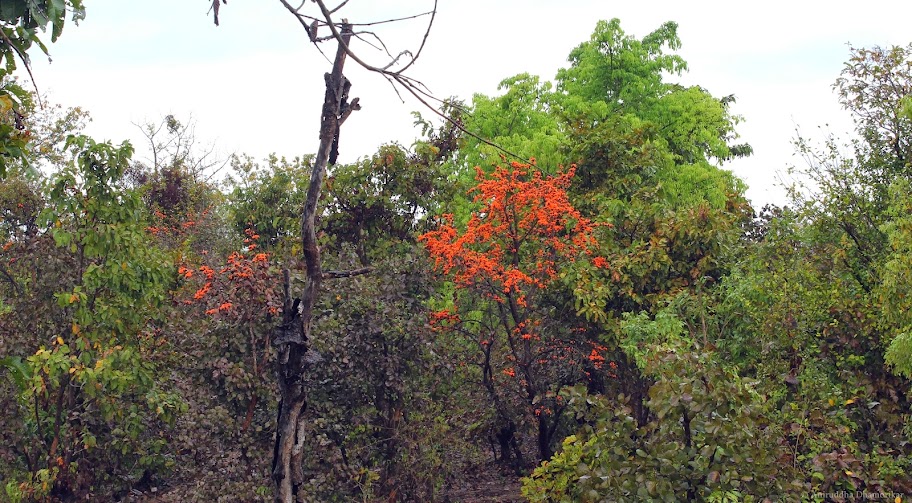 |
| The Palash tree I sat under; on a cloudy day |
It stands just beyond a small perennial pond, near the bank
of a dried-up stream that arises from this pond and joins Jamunia several
hundred yards further. The tree stands about four meters from ground, is a
little bent at the base, and branches into two before it rises straight up. It
bears scars of hacking near its base which appear to have healed, and up high
on its crown rests a magnificent coronation of flowers like little oil lamps
setting the forest ablaze.
The tree is probably a decade or two old. I noticed it first
last summer, when it scarcely blossomed and soon shed leaves. It now stands
magnificent amongst trees that are either shedding leaves or sprouting new
ones. It is the only tree that would catch your attention if you stood by the
pond. Three other Palash stand close by, one to the left and two behind the
tree, all in their early stage of flowering.
 |
| A Purple Sunbird (male) exploring the chandeliers of Palash |
Birds of an array of colours visit this one – from the tiny
warblers and sunbirds, to treepies and woodpeckers – to relish its vast
reserves of nectar. At any point of the day, between sunrise and sundown, at
least a few birds would be occupying the tree. Most lively of the lot are the
Purple Sunbirds. Their chatter is a constant company, and you will see them
chase one another with fervor between their feeding breaks. Oriental White-eyes
are rather noisy ones, chasing each without any particular reason, chuckling to
themselves in what sounds like clicks. Both these species are content with
chasing their own counterparts, and the interspecific competition seems to be absent
– probably because there are just so many flowers to drink from.
 |
| A murmuration of Chestnut-tailed Starlings |
It is only when a band of Chestnut-tailed Starlings appeared
that they disappeared to find shelter on nearby trees with thick foliage, or visited
the newly flowering Palash trees. Although I did not see starlings
intentionally bothering the little birds, their presence in large numbers
seemed to deter them. A little flock of starlings, about three or four in
numbers, is tolerated by most birds. I once saw them feeding peacefully in the
company of Common Myna, Golden-fronted Leafbird (Chloropsis), Purple Sunbird, Oriental
White-eye, and Black Drongo. But I’ve also seen them in tens, reigning over the
tree in absence of others.
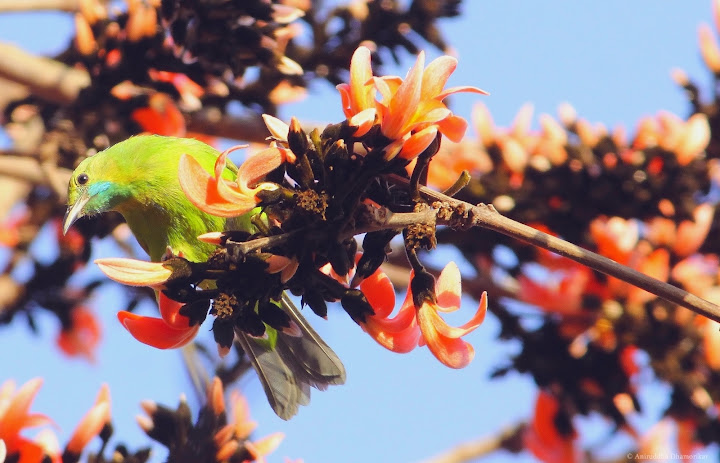 |
| A Golden-fronted Leafbird (female) looks on from a bed of Palash's inflorescence |
The Leafbirds were rather random in how they approach this
tree, perhaps because they know several others in the vicinity, or it could be
because of the fact that they are shy. But I saw them feeding contently – both
males and females – while I was calmly sitting under the tree.
 |
| A Golden-fronted Leafbird (male) feeding on Palash's nectar |
When I approached the tree, careful though I was, I
sometimes flushed the birds out. But as I settled, I noticed a trend. The
earliest birds to return were the sunbirds, closely followed by white-eyes,
warblers and tailorbirds, and later large birds like leafbirds, starlings, and
mynas also appeared.
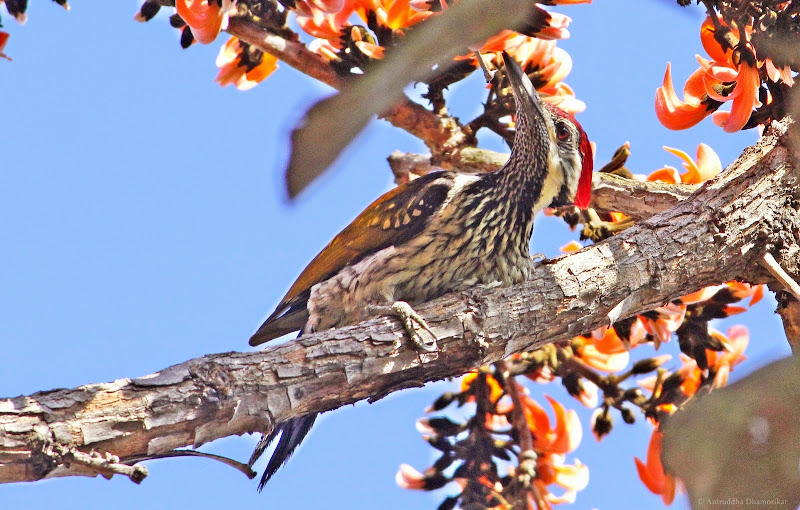 |
| A Black-rumped Flameback wodpecker takes a break from feeding |
The vagrant visitors, and most shy of the lot, are the larger
birds like Black-rumped Flameback, Rufus-bellied Treepie, Greater Racket-tailed
Drongo, and Rose-ringed and Plum-headed Parakeets – all extremely wary of my
presence. Only on a few occasions, when I hid under the lush canopy of an
adjoining Jamun (Syzygium cumini) tree,
could I observe them contently from the crack in the canopy.
 |
| Rufus-bellied Treepie (one of the courting pair) looks on through the foliage. Treepies also feed on nectar, but they were also seen intently plucking flowers and dropping them to the ground. |
What’s curious is that all these birds vary in their habits,
and their beaks are of a variety of shapes, adapted to what they feed on. On
Palash, they all converge; broad-billed, short-billed, and needle-billed alike;
feeding on the nectar with sheer delight. The Palash tree has evolved itself to
make the best out of this: to get itself pollinated.
 |
| Oriental White-eye, seen with a bindi on its forehead - probably a mark left behind by Palash's pollen. The exposed filament and stigma can be seen just below the beak of the bird. |
Most birds that have been feeding on Palash’s nectar carry a
bindi on their foreheads – a saffron
mark left there by the anthers of Palash’s strategically designed flowers.
Appearing like a set of jaws, the flowers of Palash open
outward from the branches, and their inflorescence creates a bed on which birds
can land and feed. The birds require to reach inside the mouth of the flower
for the nectar in a peculiar way, and while doing so, their crown (or throat –
whichever way the flower or bird is oriented), rubs against the folded petal that
enclose filaments carrying anthers and a style carrying stigma. As the birds
try to reach further in for nectar, the filaments get exposed, and rub against the
bird, transporting pollen with a hope that they will be cross-fertilized when
the bird visits another tree to feed upon.
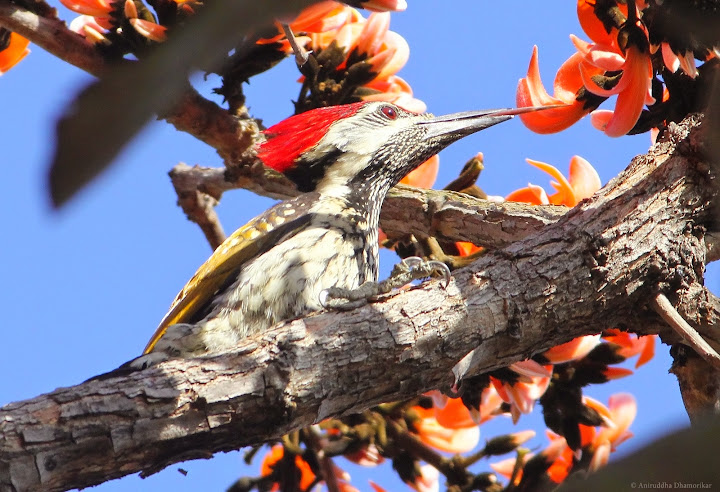 |
| A Black-rumped Flameback feeding on nectar using its long tongue; in such instances pollination fails |
Some birds, though, also feed from the side, or the flower
grows in an awkward shape to reach in properly, completely skipping the
intricate mechanism set in place by the tree. Most birds would try to reach in
for nectar in any way possible. I saw a Black-rumped Flameback woodpecker feed
on the nectar using its long tongue from far.
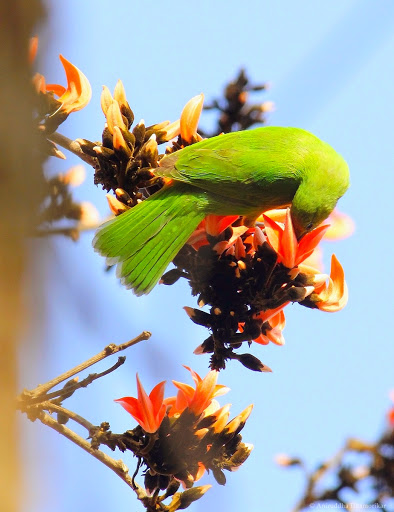 |
| A Golden-fronted Leafbird (female) feeds in the typical manner which helps the tree transplant its pollen onto the bird's crown |
Almost all the birds like the Tailorbird, Purple Sunbird,
Oriental White-eye, Black Drongo, Golden-fronted Leafbird, Chestnut-tailed
Starling, and Common Myna, feed as per the mechanism set in place by the tree
(if the flower is properly placed) owing to their small sizes or shorter beaks.
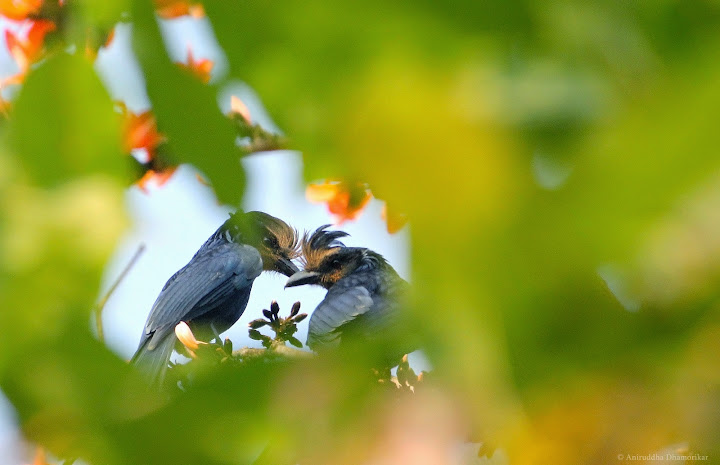 |
| A pair of Greater Racket-tailed Drongos masked with pollen |
I once saw a pair of Greater Racket-tailed Drongos with a
rather exotic colour on their faces – only to realise that it was the pollen
they were smeared with (which likely belonged to a neighbouring Semal (Bombax ceiba) tree that is also
currently in full bloom).
The reason why so many birds converge on this tree was quite
interesting and boldly apparent: its colour. Trees in summer (like Palash, Semal
or Red Silk Cotton Tree, and Indian Coral Tree (Erythrina spp.)) often blossom in bright shades of reds to attract
birds.
Birds are sensitive to light around 570 nm in wavelength (i.e.
light between green and red) thanks to the presence of the cone pigment “iodopsin”
(Varela et al., quoted in Wikipedia).
And almost all trees relying on birds for pollination are known to have
brightly coloured flowers in this same visible wavelength, exploiting a bird’s
excellent sense of vision. This colour is what makes Palash’s profusion stand
out in the landscape, attracting birds from far, and ensuring the passing of
its progeny.
Plants that flower in shades of purple and violet (around
300 nm according to Markha et al, 2004 and Backhaus et al, 1998, quoted in Wikipedia),
do so to attract another efficient
pollinator: insects. Although insects visit a variety of flowers irrespective
of their shape, colour, and scent, purple and violet colours are much more
common in plants during monsoon, probably to attract insects which are higher
in diversity and density during this season.
Read more about this
hypothesis in On a
few Wonders of Sahyadri.
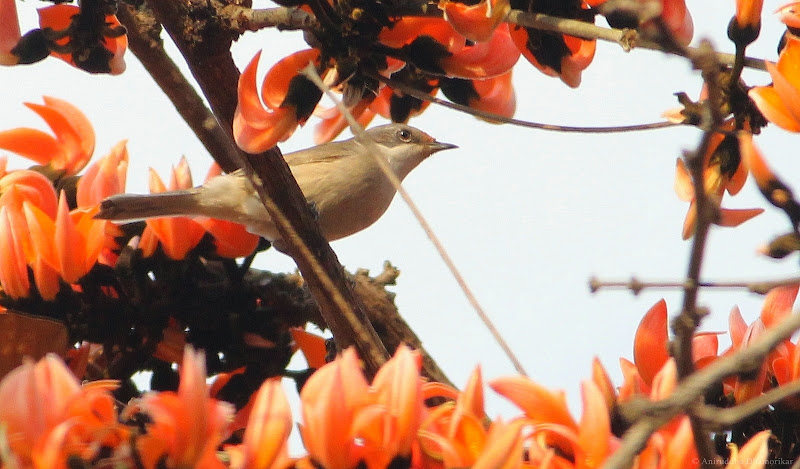 |
| A Lesser Whitethroat - a winter migrant and rather uncommon visitor of Kanha's forests, carrying the bindi near its beak |
As I sat under this Palash tree, I began to wonder about
these intricate relationships plants have with animals. Both are subconsciously
providing crucial services to one another, maintaining the balance in an
ecosystem. What if this mechanism was adopted for afforestation and habitat
restoration?
Although several scientific methods are being applied for such
initiatives, exploiting the visual aspects of trees and pollinators is crucial
to invite the diversity of life into a degraded ecosystem. In case of Palash
which is found across India, it can be vital in long-term conservation of
afforestation projects, because they invite a diversity of other animals to the
area. Similarly, trees like Red Silk Cotton Tree and Indian Coral Tree can be
used in such programmes as well.
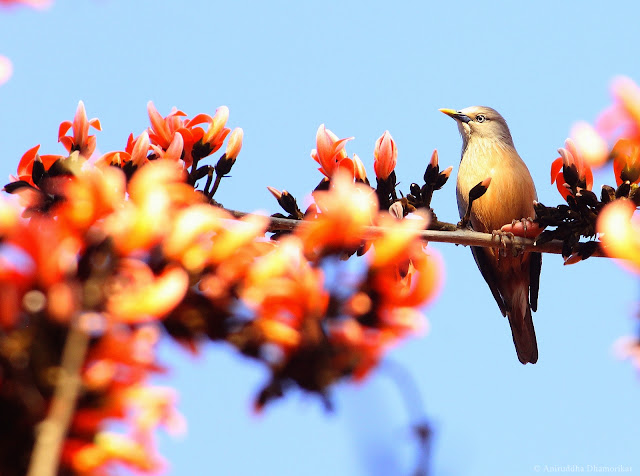 |
| A Chestnut-tailed Starling looks on from its perch amidst flaming flowers |
My theory is based on this premise: When I sat under the
tree, I represented the disturbance (in the presence or absence of the tree)
because of which no birds would arrive. Then, they noticed I had settled down –
or probably left – and in my place stood a Palash tree in its full blossom.
Soon, the most tolerant of the lot, the sunbirds, white-eyes, tailorbirds and
warblers arrived – followed closely by leafbirds, starlings, and mynas – and
later by other larger birds like parakeets and mammals like squirrels. This
completed the picture – the birds fed, the tree pollinated, and a balance between
the two was set in place.
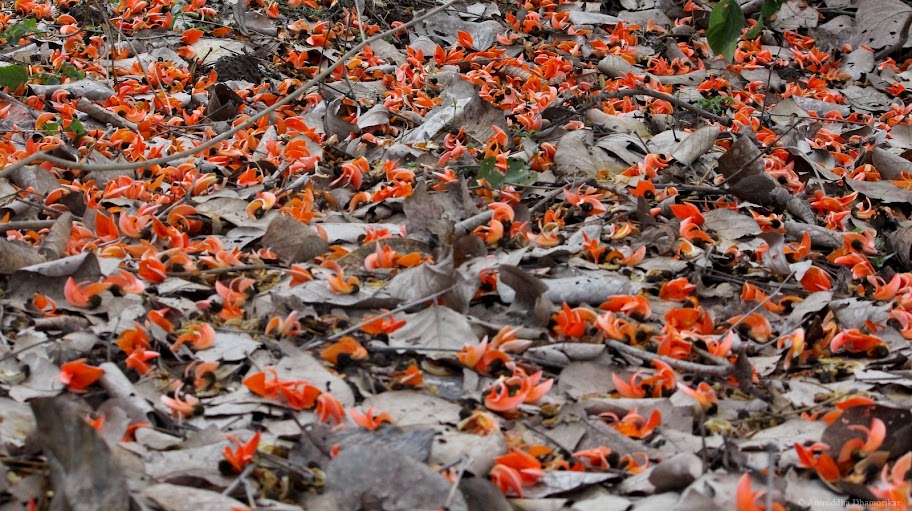 |
| A carpet of Palash flowers under the tree |
Unfortunately, most plant nurseries do not breed these
species, and therefore obtaining them is difficult. The logic of plantations of
Eucalyptus and Acacia, which is still rather prevalent in Central India even today,
is not ecological, yet their saplings are still common in nurseries. Adopting a
‘visual invitation approach’ by using
indigenous trees which produce flashy flowers will help in the process of attaining
a balance in an ecosystem, if used in combination with other species.
 |
| An Oriental White-eye takes a break from feeding |
It is important to understand relationships between plants
and animals, not only for mere research, but because they can help us bring
back the forests that we have destroyed, and trees – multitudes of them – to sit
under and gaze upon. I still sit under this Palash tree, and will continue to
do so whenever I get time, with a hope that by being one with the landscape
I’ll find more about this tree’s secret. By doing so, I think that I’m as much as
a starling or a treepie, only without wings.
Birds observed feeding on the Palash tree I sat under:
1. Purple Sunbird
2. Oriental White-eye
3. Common Tailorbird
4. Greenish Warbler (?)
5. Lesser Whitethroat
6. Golden-fronted Leafbird
7. Chestnut-shouldered Petronia
8. Red-vented Bulbul
9. Chestnut-tailed Starling
10. Common Myna
11. Black Drongo
12. Rufus-bellied Treepie
13. Greater Racket-tailed Drongo
14. Black-rumped Woodpecker
15. Rose-ringed Parakeet
16. Plum-headed Parakeet
Birds that visited but did not seem to feed:
17. Common Rosefinch
18. Spotted Dove
Other birds observed feeding on Palash in the same locality (added on March 13, 2015):
19. Brahminy Starling
20. Alexandrine Parakeet
21. Black-hooded Oriole
Other birds observed feeding on Palash in the same locality (added on March 13, 2015):
19. Brahminy Starling
20. Alexandrine Parakeet
21. Black-hooded Oriole
All photographs were taken on the single Palash tree I sat under.

Excellent read as always !!
ReplyDeleteThe weather though harsh this time around the year, the tree is magnificent with its blossom. The seed pods hanging by the bunch also makes for a pretty sight amongst those where the flowers had reduced significantly.
Silently waiting for more in this space. Best wishes !! Cheers.
Awesome article please provide more this type article
ReplyDelete👌👍 liked the article and can relate with it
ReplyDelete